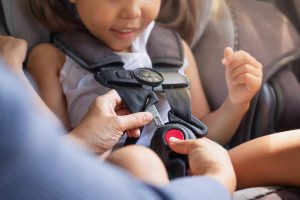
The safest place for small children is in an age-appropriate car seat in the backseat.
Two Toddlers Rescued from Interstate After Houston Crash
According to a KSAT News report, two toddlers ejected from a car crash were rescued from the Interstate on Sunday evening.
Police reported the accident happened at around 7 p.m. on August 11th, on I-10 near the Freeport Street exit in East Houston. A Chrysler attempted to change lanes into a lane where a Jeep Wrangler was traveling, causing a collision that flipped the Jeep. The children, ages 1 and 4, were ejected onto the Interstate, wearing nothing but diapers. The father of the children and a bystander rescued them from the wreckage. The 25-year-old father and the children were taken to a nearby hospital with non-life-threatening injuries. No charges have currently been filed against the father, but he could face charges for not properly restraining the children. The driver of the Chrysler was unharmed.
Did You Know?
An estimated 46% of car seats are misused, according to the NHTSA.
What Car Seat is Right for My Child? (Texas 2024)
Car accidents are a leading cause of death among children in the United States.
The best way to protect your child from an auto accident is to place them in an age-appropriate car seat. Texas law requires that all children younger than 8 (unless they are taller than 4″9′) must be secured in a child safety seat for this reason.
You can face criminal charges if you don’t comply with these laws. The following is a brief overview of the appropriate seat for your child.
Choosing the Right Car Seat
Knowing when your child should transition from one seat to another is based more on height and weight than age. However, the following are general guidelines for an age-appropriate seat.
Infants to 2 years
Infants to 2 years should ride in a rear-facing safety seat unless the child meets the height and weight requirements listed on the seat before age 2. However, it is generally recommended that the child should be at least older than one before switching.
2 to 5 years
Children two and older should ride in a convertible/forward-facing safety seat. They should continue in this seat until the highest weight and height limits listed on the seat are exceeded. This also applies to any child younger than 2 years who has outgrown the rear-facing weight or height limit of their seat.
5 to 12 years
Children who have outgrown the maximum height and weight requirements of a forward-facing seat can switch to a booster seat. This usually occurs around age 5. After they have reached 4 feet, 9 inches, they may use a regular seat belt. This usually occurs around age 8 but will vary from child to child.
There are no age restrictions for when a child can ride in the front seat. However, car seats should never be placed in the front seat, and it is generally not advisable for children to ride in the front until they are at least 13. If you must place a car seat in the front seat, turn off the passenger airbag and push the seat as far back as possible.
Was Your Child Injured in an Auto Accident? Call Shaw.
If your child was injured in an accident that wasn’t your fault, you may be entitled to compensation for things like:
- Ambulance Costs,
- ER Treatment,
- Surgeries,
- Trauma/PTSD,
- Pain and Suffering,
- Wrongful Death,
- And More.
We’ll help you find out if you have a case for free.
Call Shaw at 800-862-1260 to schedule a free consultation with a child injury attorney today. No fees, no obligations, just expert legal advice. We look forward to serving you.
 Texas Accident & Injury News
Texas Accident & Injury News

